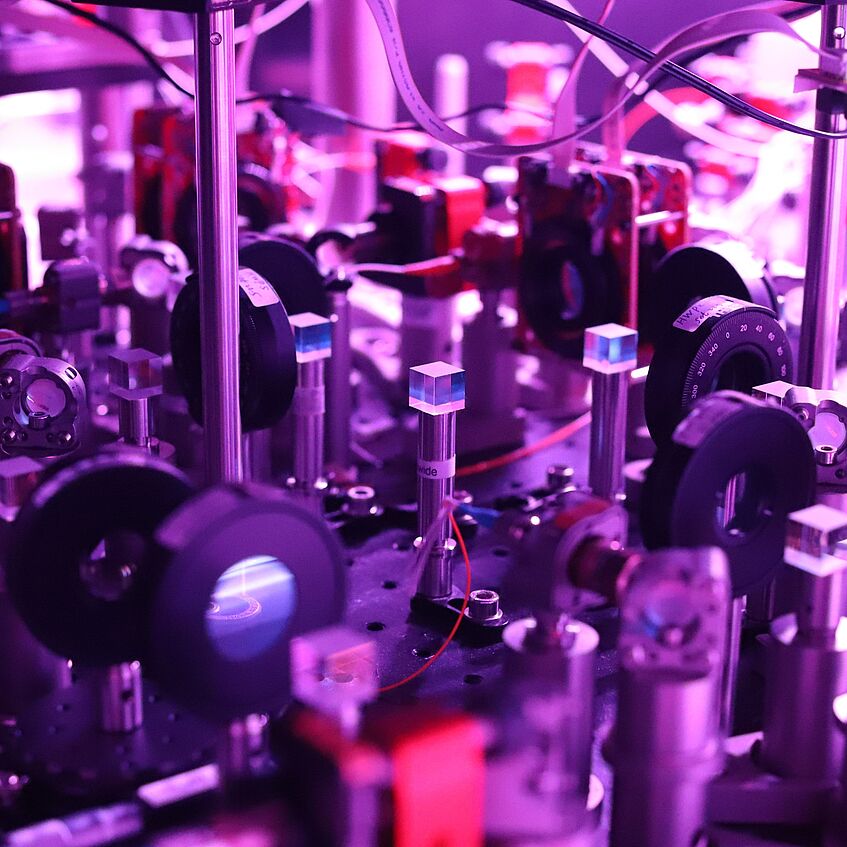Photonic Quantum Computing

Detail of the experimental apparatus for the generation of the 3-photon heralded GHZ state.
(c) Lena Hansen
Photonic Quantum Computing
Photonics is one of the most widely used platforms to perform quantum computation, mainly due to the ease of manipulating qubits with high fidelity. Moreover, the developments in integrated photonics allow to miniaturize optical elements, granting better stability and lower space requirements. These ingredients are pivotal for scaling quantum apparatuses towards large-scale quantum computers. This is particularly relevant, considering the necessity of fault-tolerant computers, which require many photonic components. These should also perform beyond the state of the art of conventional integrated photonics— e.g. through high-efficiency single-photon detectors and highly reliable and bright single photon sources.
Besides the hardware, recent theoretical work on measurement-based quantum computation has jolted the field with new ideas, leading to breakthrough results. This model requires the creation of large clusters of entangled states, where computation is implemented via measurements on single qubits. In this context, a key element is active feed-forward, to keep track of the individual measurement results. This significantly reduces the required resources and increases the threshold for tolerable losses.
In our group, we deal with both the aspects, i.e. investigating novel quantum hardware and implementing building blocks for quantum computing. Hence, on one hand, we investigate feasible experimental techniques to scale to higher dimensional computational protocols. For example, we adopt single photon sources performing at state-of-art levels (i.e. InGaAs quantum dots coupled to a micro-pillar cavity) and we focus on the design and implementation of time-based architectures, where non-classical correlations are distributed on time bins, rather than on spatial modes. We also widely resort to programmable integrated optical circuits, consisting of waveguides drawn on borosilicate glass or silicon on silica substrates, to perform adaptive computational protocols, e.g. for machine learning scopes, variational quantum algorithms or quantum computational operations. These devices are provided by the group of prof. Roberto Osellame (Politecnico of Milan, Italy) and of prof. Dirk Englund (MIT, USA), with which the group has long and fruitful collaborations. We also resort to fast-switches to implement high-fidelity feed-forward operations.
On the other hand, we work on the generation (and verification) of large cluster states, e.g. GHZ states. Recently, the group has implemented and fully characterized a 3-photon heralded GHZ state, which is currently the largest size reported in literature. This experiment marks a steady progression towards multipartite systems, allowing for quantum photonics protocols that were previously inaccessible and removing the constraints of outcome post-selection. These research topics are also framed in the context of several prestigious international research projects, towards the realization of a large-scale European quantum computer.
Publications (selected)
Programmable multiphoton quantum interference in a single spatial mode
L. Carosini, V. Oddi, F. Giorgino, L. M. Hansen, S. Piacentini, T. Guggemos, I. Agresti, J. C. Loredo, P. Walther,
Science Advances 10, eadj0993 (2024).
Photonic Source of Heralded Greenberger-Horne-Zeilinger States
H. Cao, L. M. Hansen, F. Giorgino, L. Carosini, P. Zahálka, F. Zilk, J. C. Loredo, and P. Walther
Physical Review Letters 132, 130604 (2024).
Experimental photonic quantum memristor
M. Spagnolo, J. Morris, S. Piacentini, M. Antesberger, F. Massa, A. Crespi, F. Ceccarelli, R. Osellame, P. Walther,
Nature Photonics 16, 318–323 (2022).
Experimental quantum speed-up in reinforcement learning agents
V. Saggio, B.E. Asenbeck, A. Hamann, T. Strömberg, P. Schiansky, V. Dunjko, N. Friis, N.C. Harris, M. Hochberg, D. Englund, S. Wölk, H. J. Briegel, P. Walther,
Nature 591, 229–233 (2021).
Experimental few-copy multipartite entanglement detection
V. Saggio, A. Dimić, C. Greganti, L. A. Rozema, P. Walther, B. Dakić,
Nature Physics 15, 935–940 (2019).
Integrated-optics heralded controlled-NOT gate for polarization-encoded qubits
J. Zeuner, A.N. Sharma, M. Tillmann, R. Heilmann, M. Gräfe, A. Moqanaki, A. Szameit, P. Walther,
npj Quantum Information 4, 13 (2018).
Generalized Multiphoton Quantum Interference
M. Tillmann, S.-H. Tan, S.E. Stoeckl, B.C. Sanders, H. de Guise, R. Heilmann, S. Nolte, A. Szameit, P. Walther,
Physical Review X 5, 041015 (2015).
Experimental Boson Sampling
M. Tillmann, B. Dakic, R. Heilmann, S. Nolte, A. Szameit, P. Walther,
Nature Photonics 7, 540-544 (2013).
